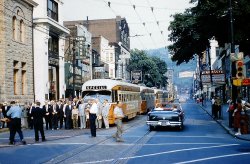
MAY CONTAIN NUTS

Search Shorpy
SHORPY ART

Framed or unframed, desk size to sofa size, printed by us in Arizona and Alabama since 2007. Explore now.
Join and Share
Ad-Free Shorpy
Shorpy is funded by you. Patreon contributors get an ad-free experience.
Learn more.

Recent comments
- Alas, hidden from view
- Exclusive pump
- Details, Details
- What's that building to the left of the tower?
- Coal Barges
- Bromo-Seltzer
- Inner harbor
- The Basin
- What a headache!
- Giant stepladder?
- Baldwin 62303
- Baldwin VO-1000
- Cold
- No expense spared
- Tough Guys
- Lost in Toyland
- And without gloves
- If I were a blindfolded time traveler
- Smoke Consumer Also Cooks
- Oh that stove!
- Possibly still there?
- What?!?
- $100 Reward
- Freeze Frame
- Texas Flyer wanted
- Just a Year Too Soon
- WWII -- Replacing men with women at the railroad crossing.
- Yes, Icing
- You kids drive me nuts!
- NOT An Easy Job
Member Photos
The Shorpy
Print Emporium
Print Emporium
Search Shorpy
Search results -- 30 results per page
- Iced Tea Terrace: 1945
- ... was named Clayton, after the home he grew up in - the Pittsburgh estate of his father, Henry Clay Frick. Childs felt he didn't ... Posted by Dave - 03/06/2017 - 10:12pm -
![Iced Tea Terrace: 1945 October 13, 1945. "Childs Frick residence in Roslyn, Long Island, New York. Guest cottage south facade." 5x7 negative by Gottscho-Schleisner. View full size.
LovelyI want to hang out here.
[There's a quality that draws me as well. I can't quite put a name to it. -tterrace]
Clayton 2This estate was named Clayton, after the home he grew up in - the Pittsburgh estate of his father, Henry Clay Frick. Childs felt he didn't inherit what he should have; I'd say he did alright.
It's Seen Better DaysWhile the historical view looks like the kind of place where Kathryn Katharine Hepburn might have been seen planning a cinematic weekend, the modern view of what's best known as the Jerusha Dewey House shows that time hasn't been so kind.
[This photo dates from 2008, three years before the 2011 restoration seen in the later comment. -tterrace]
And better days are here againNow owned by the Nassau County Museum of Art, and all fixed up.
Re: LovelyCompared with the blunt angles of the two photos provided below, the half-profile of the guest cottage is a far more flattering and intriguing view. Framed by the tree above and descending flagstone pathway drawing the eye in, not to mention the delightful volumes and good bones of the house itself, the scene is utterly charming. Gottscho uses his mastery of lighting to great effect, imparting an almost cinematic quality to the scene, which heightens the fantasy allure and attracts us even more. I expect to see a young Judy Garland run out laughing at any moment, or maybe a smart-talking Katharine Hepburn in trousers.
(The Gallery, Gottscho-Schleisner)](https://www.shorpy.com/files/images/SHORPY-5a12272u.thumbnail.jpg)
- Game Day: MCMXIII
- ... to score a point. After starting out the season tying Pittsburgh 0-0, future vice-admiral John H. Brown Jr. and his teammates ... Posted by Dave - 02/02/2014 - 12:01pm -
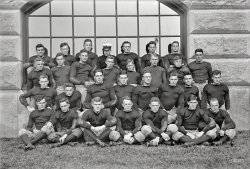
- Duquesne Steel: 1909
- ... this post from Sept. 8.
If so inclined We visited Pittsburgh during the bitterly cold March of 2017 and, despite the chilly ... Posted by Dave - 10/02/2020 - 11:50am -
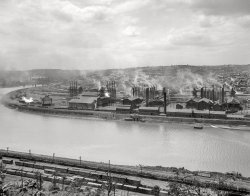
- Sternwheel Tow Boat Ironsides: c.1910
- The Pittsburgh Sternwheel Tow Boat "Ironsides" was built in Pittsburgh, Pennsylvania in 1869 and was in service until she sank at Point ... on August 6, 1927. Since there's no "h" in the spelling of Pittsburgh on the stern that dates the picture to between 1890 and 1911. More ... Posted by D_Chadwick - 08/29/2017 - 7:18am -
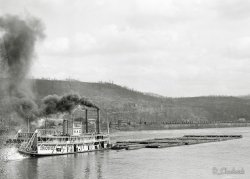
- Phipps Garden: 1940
- ... Benefactor Henry Phipps (1839-1930) grew up poor in a Pittsburgh tenement and became a friend of a neighbor, the Scottish immigrant, ... Posted by Dave - 05/10/2014 - 10:04am -
![Phipps Garden: 1940 May 17, 1940. "Phipps Garden Apartments, 5101 39th Avenue, Long Island City, New York. Clarence S. Stein, architect." Hanging with a big girl whose feet touch the ground. Large-format negative by Gottscho-Schleisner. View full size.
An early housing experimentPhipps Gardens is still a desirable development after all these years. It's owned and managed by a nonprofit corporation, with apartments made available at affordable rents to people who meet income guidelines. The concept is similar to the neighboring and larger Sunnyside Gardens, though the latter development is a cooperative rather than rentals. Both developments were inspired by the English "Garden City" movement and built by a corporation headed by various dignitaries including Eleanor Roosevelt. The idea was that providing working-class people with (relatively) low density housing that included ample open space would cure many of the social ills associated with tenement life. Whether or not that experiment succeeded or not is hard to say, but given that the developments remain quite nice today a qualified "yes" may be in order.
The photo's caption notwithstanding, Phipps Garden is not in Long Island City. As the name of its neighbor Sunnyside Gardens suggests, it's in the Sunnyside neighborhood. While Long Island City has gotten a bigger influx of affluent people who work in Manhattan, Sunnyside is a desirable neighborhood itself with its tree-lined streets and a bit of a small town feel. In the 1940's and 1950's it was known as New York's nursery on account of the high birthrate among the young families living in the area.
Current view of Phipps Garden:
View Larger Map
BenefactorHenry Phipps (1839-1930) grew up poor in a Pittsburgh tenement and became a friend of a neighbor, the Scottish immigrant, Andrew Carnegie. He worked for Carnegie as a bookkeeper. Carnegie Steel was merged with the steel companies controlled by another Robber Baron, Henry Clay Frick in 1901. Phipps part of the deal earned him $69.5 million, worth today, just slightly south of 2 Billion. His family Bank, the Bessemer Trust, controlled now by his Great Grandson, Stuart S. Janney III, was able to increase the net worth many times. Phipps became a Philanthropist building affordable housing for NYC Working People. Thousand of housing units have been built over those years, including those in today's Blog. Attached is a shot of Henry Phipps Plaza in the Kips Bay Section of Manhattan.
HeyHula Hoops weren't invented till the 60's, what is that?
[Wham-O's hula hoop dates from 1958, but hoop rolling has been around for centuries. -tterrace]
Sunnyside/Astoria/Long Island CityPhipps is in zip 11104; the post office's preferred designation is Sunnyside, but Long Island City and Astoria are also acceptable for parts of the zip. For a while in college I was a Fuller Brush salesman in this general area. Lots of 4-6 story walkups. I didn't last too long.
(The Gallery, Gottscho-Schleisner, Kids, NYC)](https://www.shorpy.com/files/images/SHORPY-5a05074u.thumbnail.jpg)
- Queens of all the Air: 1952
- ... at the Allegheny County Airport, southeast of Pittsburgh, Pennsylvania. Circa 1952. Scanned from a Kodachrome stereo slide ... Posted by ceraurus - 02/19/2019 - 9:48am -
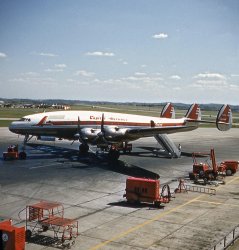
- Steelhenge: 1908
- ... would greet me as I passed through the steel mills near Pittsburgh. At night the ingots would glow red/orange in the dark, each one a ... Posted by Dave - 06/05/2016 - 6:01pm -
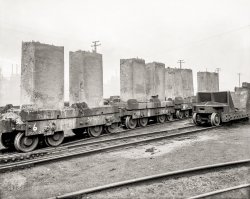
- Heart of Gold (Colorized): 1942
- November 1942. "Pittsburgh, Pennsylvania (vicinity). Montour No. 4 mine of the Pittsburgh Coal Company. Coal miner at end of the day's work." Medium-format ... Posted by Don Wagoner - 05/31/2010 - 11:41am -
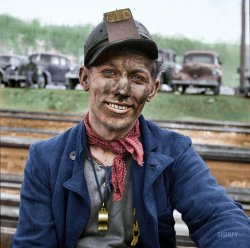
- Modern Forest: 1941
- January 1941. "Stacks at the Pittsburgh Crucible Steel Company in Midland, Pennsylvania." Medium format ... Posted by Dave - 11/04/2019 - 2:45pm -
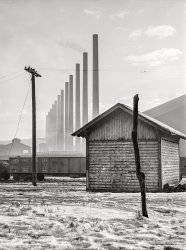
- Pennsy Es on the Horseshoe Curve
- ... in the early 80s, I had the opportunity to ride from Pittsburgh to Altoona on the head end of a freight train. Went by this spot ... Posted by notycoon22 - 06/03/2007 - 12:47pm -
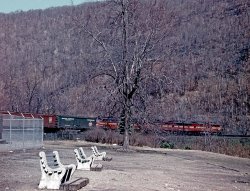
- Name That Ship!
- ... the Semester at Sea program sponsored by the University of Pittsburgh and administered by the Institute for Shipboard Education.
... Posted by Jim Page - 09/21/2012 - 9:35pm -
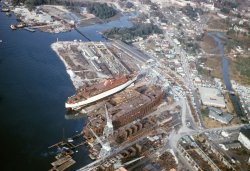
- The Night Air: 1941
- ... Studebaker and drive to one of the steel mills around Pittsburgh for a show of beehive coke ovens being emptied, a Bessemer converter ... Posted by Dave - 02/18/2020 - 8:45pm -
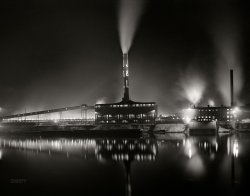
- Bus Stop: 1943
- ... filling station to get water between Washington, D.C., and Pittsburgh." Medium format nitrate negative by Esther Bubley for the Office of ... Posted by Dave - 06/08/2018 - 4:17pm -
![Bus Stop: 1943 September 1943. "A Greyhound bus that has been stopped at a filling station to get water between Washington, D.C., and Pittsburgh." Medium format nitrate negative by Esther Bubley for the Office of War Information. View full size.
A Raymond Loewy beautyThe bus in question is "Yellow Coach" model 743 or 719 (not enough of the photo to tell which). This bus was a real ground-breaker in terms of design.
The Yellow 719 "Super Coach" was the first truly modern interstate bus. Designed by Ray Loewy, this bus was a totally new concept in that it was the first to have a raised passenger deck with a large luggage space underneath between the axles. All modern interstate buses still have that same design. The 719 (gasoline-powered) was made from 1936 and the similar 743 (diesel powered, with air conditioning) came along in 1937. Yellow made both models until around 1939.
A restored Yellow 743 coach may be seen here:
https://www.flickr.com/photos/busdudedotcom/15800920762/
A smoking gunCouldn't help notice he's pouring gas into a bus while smoking a cigarette. Hmmmmm. A disaster just waiting to happen.
[Hmmm. Did you READ THE CAPTION? That's water, not gas. (And what bus company or filling station would ever use a garden watering can for fueling?) - Dave]
AS I SAID earlier, yes, I missed the word 'water'. Reading it again, I thought it was gas. My mistake.
(The Gallery, Esther Bubley, Gas Stations)](https://www.shorpy.com/files/images/SHORPY-8d32733a.thumbnail.jpg)
- Cathedral of Learning: 1948
- The University of Pittsburgh main campus in Pittsburgh, circa 1948. This is from a scan of a stereo slide taken by my ... Posted by ceraurus - 12/12/2018 - 11:50am -
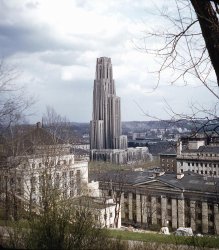
- Wildcats: 1893
- ... her small but beautiful mausoleum at Allegheny Cemetery in Pittsburgh, when I visited there in March of 2017. Over the ornate bronze doors ... Posted by Dave - 06/23/2019 - 1:03pm -
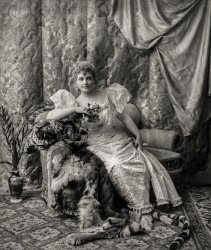
- No smoke, no work
- ...
My father grew up in here, just up the Monongahela from Pittsburgh. He did not return after getting out of the Marines in 1946. Every ... Posted by jbart - 09/20/2011 - 1:10pm -
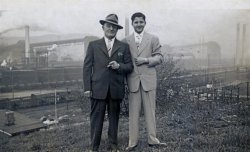
- Working Class Heroes: c. 1910
- ... Butler County Pennsylvania located about 20 miles North of Pittsburgh. Scanned from the original 5x4 inch glass negative. View full ... Posted by D_Chadwick - 01/13/2011 - 9:30am -
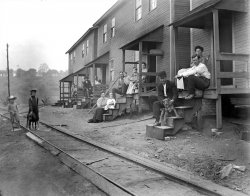
- C&P: 1906
- Cleveland circa 1906. "Cleveland & Pittsburgh ore docks." 8x10 inch dry plate glass negative, Detroit Publishing ... Posted by Dave - 10/28/2018 - 4:24am -
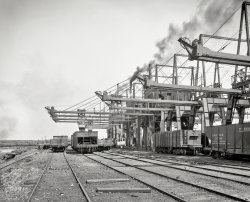
- Industrial Strength: 1901
- ... it was being built at this time. The 'P' is probably Pittsburgh Steamship Company, but uncertain.
The Cargill salt mine now ... Posted by Dave - 05/28/2019 - 7:29pm -
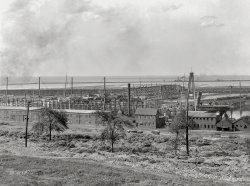
- Denale Family
- ... and my father came to the USA early 1900s. Lived around Pittsburgh
PA area. All others born here.
There were also 9 children on ... Posted by denalm - 02/01/2021 - 7:27am -
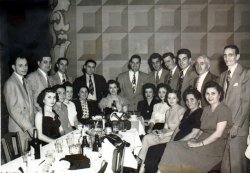
- Good Buddies
- ... Army. So they made it down to the recruiting station in Pittsburgh. For some reason Gigi was not allowed in. So much for that plan ... Posted by jbart - 11/30/2007 - 2:57pm -
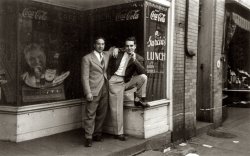
- Grand Finale: 1960
- ... were streetcars remaining in other large cities such as Pittsburgh, Los Angeles, Philadelphia and San Francisco, but Johnstown was the ... Posted by prrvet - 06/27/2020 - 11:09am -
